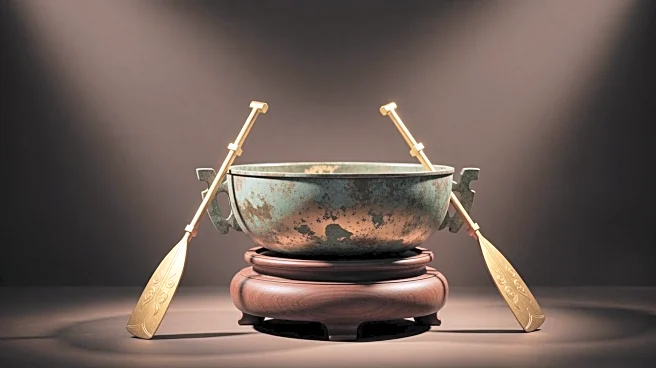What's Happening?
The Caergwrle Bowl, a 3,300-year-old artifact, has been unveiled by Museum Wales, showcasing its historical significance as a representation of nautical travel during Great Britain's Middle Bronze Age.
Discovered 200 years ago in a boggy field in Wales, the bowl is made from shale and tin sourced from southwest England, with gold from Ireland or Wales. The artifact, which originally measured 7.2 inches long and 3.1 inches deep, features gold-foil-covered tin decorations on its exterior, believed to symbolize waves, oars, and protective eyes. These designs suggest the bowl was created as a representation of a ship, possibly serving as a votive offering by sailors seeking safe passage. Nautical archaeologists have debated the interpretations of the bowl's designs, with some suggesting parallels to Bronze Age sun symbolism.
Why It's Important?
The unveiling of the Caergwrle Bowl provides valuable insights into the maritime culture and religious practices of the Middle Bronze Age in Great Britain. The artifact's intricate designs highlight the significance of nautical travel and the symbolic protection sought by sailors during this period. The bowl's discovery in a bog, a common site for Bronze Age offerings, suggests it was used in rituals to ensure safe sea journeys. This finding enriches our understanding of ancient maritime practices and the cultural importance of nautical symbolism. The artifact also contributes to the broader study of Bronze Age art and religious artifacts, offering a unique perspective on the intersection of art, religion, and maritime history.
What's Next?
Further analysis and study of the Caergwrle Bowl may provide additional insights into its origins and the cultural context of its creation. Researchers may continue to explore the artifact's designs to better understand the symbolism and its connection to other Bronze Age artifacts. Museum Wales may also engage in public exhibitions and educational programs to share the bowl's historical significance with a wider audience. These efforts could foster greater appreciation for ancient maritime cultures and their contributions to historical art and religious practices.
Beyond the Headlines
The Caergwrle Bowl's discovery and subsequent analysis highlight the ethical considerations in preserving and interpreting ancient artifacts. As researchers debate the artifact's symbolism, it underscores the importance of interdisciplinary approaches in archaeology, combining historical, artistic, and cultural perspectives. The bowl's preservation and display by Museum Wales also reflect broader efforts to protect and share cultural heritage, ensuring that such artifacts remain accessible for future generations to study and appreciate.













